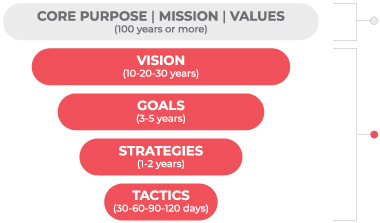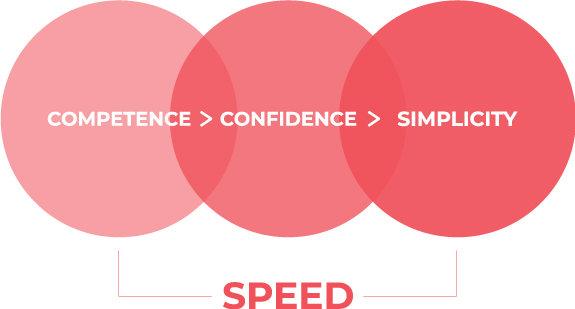
The Adaptive Advantage
Strategic Planning in an Environment of Continual Change
Perhaps you’ve seen some of the headlines in the business press questioning the value of a strategic plan given the pace of change in today’s business environment. We are, after all, now living in a world where many of our past solutions don’t apply and the rules keep changing. So it’s not surprising that there are many strategists who are arguing for a focus on agility and execution over having a comprehensive plan.
In reality, rumors of the death of strategic planning have been greatly exaggerated.
Amid today’s rapidly changing business environment there is one true competitive advantage: speed of adaptability. And, this adaptive advantage only comes from taking the time to look to the horizon, identify patterns to develop a realistic view of the big picture, and explore all of the possible approaches to it.
While the need for strategic planning has not gone away, the approach most certainly has evolved. The big trends we are seeing in our work with clients revolve around three key areas:
1. Shorter Time Horizons
For years, businesses have operated under there, five, and 10-year plans. Today, consolidation is the new norm. Shifting business models and social entrepreneurs are changing consumer behaviors. And, disruptive technologies are being introduced daily, altering the competitive landscape and ensuring there isn’t a single industry that isn’t undergoing change.
The accelerating pace of change is most evident in technological advances, which are growing at a rate never seen before. Uber introduced self-driving vehicles in Pittsburgh this past September bringing autonomous vehicles to the masses. Google’s new Daydream View Headset is making virtual reality more accessible, which could have sweeping implications for sales experiences, education, and even everyday meetings. And in Louisville, KY, solar-powered trash cans are now functioning as free Wi-Fi hot spots for Internet users, making the once conceptual “Internet of Things” a very practical reality.
In this ever-changing landscape, strategy has become a continuous process rather than an annual one, and the strategic plan itself needs to be more fluid and more focused to ensure it continues to advance the organization toward its vision. As a result, more businesses are opting for quarterly reviews of environmental factors and strategies, and even more frequent reviews of tactics. These mid-course corrections also include more frequent competitive reviews. Those who aren’t keeping an eye on industry data and the activities of their competition are more likely to be leapfrogged. Today, quarterly reviews have become table stakes.
On the up side, shorter time horizons and the speed of technological advances are also helping companies to achieve their strategies much more quickly. Harnessing the speed of change through focus and efficiency can turn these shorter time horizons into a powerful ally.
2. Enduring Meaning
While adaptation is essential to survival, so is an appropriate level of preservation. Having a guiding star amid the change — the parts of the business that are so inherent they drive decisions and behaviors — can become the foundation upon which change is built.
For this reason, more companies are taking time to ensure the company’s core purpose, mission, and core values are not just articulated, but also understood and lived by everyone in the organization. These guiding principles (in combination with the long-term vision) become the guardrails to ensure no one overreacts to change. As reflected in Exhibit A, they are also an increasingly important bridge for helping to connect the strategic plan to all levels of the organization in a way that galvanizes the entire team. After all, values drive behavior, behavior drives culture, and culture ultimately impacts a company’s performance.
In this way, our clients are also finding incredible value in the art of storytelling. They are inspiring their teams in a more personal and approachable way by telling the story of the strategic plan in a way that gives it greater meaning beyond a singular goal or strategy. Those that do this particularly well are able to get much farther in a shorter time period because their teams are fueled by personal motivations.
Enduring Meaning
Exhibit A:
 |
PRESERVATION EVOLUTION Based on the article “Building Your Company’s Vision,” by James Collins and Jerry Porras, Harvard Business Review, September-October 1996. |
3. Successful Execution
We know a plan not successfully acted upon is no better than the paper on which it is written, but successful execution takes alignment and effort from everyone in the organization, especially when being responsive to change.
Unlike previous strategic planning models, new approaches are making strategy a part of everyday work. Our clients are recognizing the importance of empowering their employees to feel ownership and impact regardless of their individual roles. This requires increased transparency and communication, but also a higher level of empowerment and accountability for all employees to give everyone the tools they need to remain action-oriented and make good decisions in the face of uncertainty.
Our clients are finding one of the greatest steps toward gaining an adaptive advantage is through investing the time and resources into building the core competencies of their employees. Shoring up baseline knowledge and skillsets and teaching employees how to think about challenges builds confidence. As reflected in Exhibit B, this can create a powerful cascading effect. Greater confidence ultimately leads to greater simplicity in how employees approach their jobs. And this simplicity, in time, ultimately results in speed.
Successful Execution
Exhibit B:

